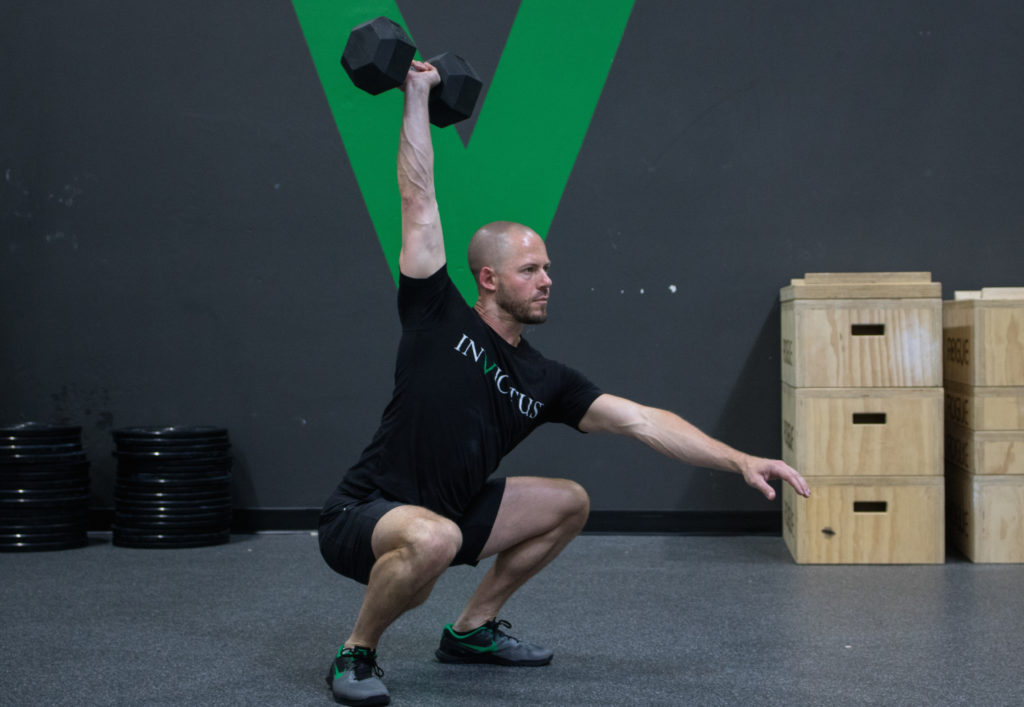
Dumbbell Overhead Squat: Exposing Mobility Sins in the Highest Level Athletes
Written by Dr. Michael Tancini
With single-arm dumbbell overhead squats at the CrossFit Regionals this year, you’re going to see some mobility holes exposed in some really awesome athletes.
The bottom position of a single-arm dumbbell overhead squat is an extremely demanding position to get into. The mobility and stability requirements for this position are huge. You’ve got to have the mobility to get into the position before you can even think about trying to be stable in the position. If you have mobility deficits in your overhead position or in your squat positioning, prepare to be humbled by the movement!
What the Single-Arm DB Overhead Squat Demands
The movement requires you to stay upright in the bottom of the squat with the dumbbell controlled over your center of mass. The further the DB moves from your center of mass, the tougher the movement will be and the more energy you will need to exert in order to control the weight overhead. With an 80-pound dumbbell overhead, any deviation of the weight outside the center of mass is likely to result in a missed rep (or close to one).
Positional Requirements
Overhead position and ankle mobility are both crucial. If you are lacking in either of these positions you’ll likely be in for a long day. But thoracic spine mobility is probably the most important piece of the equation when talking about a mature overhead position. It’s also one of the most frequent mobility restrictions I see in the CrossFit athlete. If you are looking for the place to start with improving your overhead position, it’s probably here. Try these mobility drills to start:
Thoracic Spine Band Assisted Rotation
https://www.instagram.com/p/BTSoO1MDVsP/?taken-by=groundtooverheadpt
T-spine Overhead Bias Mobilization
https://www.instagram.com/p/BLHqo8Oj-df/?taken-by=groundtooverheadpt
Shoulder Flexion (Putting the arm up overhead)
https://www.instagram.com/p/BQEcwf8DYHR/?taken-by=groundtooverheadpt
Banded-Active Shoulder External Rotation
https://www.instagram.com/p/BMaBSULjRfF/?taken-by=groundtooverheadpt
And another banded external rotation, this one providing a mobilization to both sides and the T-spine all at the same time.
https://www.instagram.com/p/BNpj9kXDsHh/?taken-by=groundtooverheadpt
Now lets work our way down the chain to the lower body – the hips and ankles. We are going to start all the way at the ground, at the ankles. Poor ankle mobility is often the biggest limitation in the majority of people I see. With restricted ankles you’re going to get greater trunk forward lean in the squat, which will put even a greater demand on the overhead position. With the overhead squat, restricted ankles will make your hips and shoulders feel much “tighter” than they actually are. With mobile ankles, you’ll be able to buffer minor restrictions up the chain (in your hips and shoulders). Ultimately, the more mobile the ankles, the easier time you’ll have keeping the dumbbell overhead.
Ankle Dorsiflexion: Banded Mobilization with Movement
https://www.instagram.com/p/BHcm6cGjEGH/?taken-by=groundtooverheadpt
Banded Ankle distraction
https://www.instagram.com/p/BJ6OU8Fjlb-/?taken-by=groundtooverheadpt
Finally lets look at the hips. You’re going to need hip flexion, hip internal rotation, and hip external rotation for the movement. This for most people will not be the limiting area in this movement. If you feel restricted in the hips at the bottom of the squat, it can probably be solved by increasing ankle mobility, increasing T-spine/overhead position mobility, and learning how to stabilize your spine during the movement (proper sequencing).
Olympic Wall Squat (for hip flexion mobility)
https://www.instagram.com/p/BHUZqr5jPGv/?taken-by=groundtooverheadpt
Hip Flexion with External Rotation
Active Hip Internal and External Rotation
https://www.instagram.com/p/BJBtNJHjKiG/?taken-by=groundtooverheadpt
Like I mentioned earlier in the article. Once you free up new ROM, you NEED to use it in a controlled manner. Banded mobilizations are a small piece of the puzzle when becoming more mobile. You need to own the range you have.
If you don’t know where to start with your mobilizations, take the time to get an assessment from a movement professional. They will be able to tell you where you’re lacking mobility and/or where all you really need is stability work. Motor control and stability deficits are often disguised as mobility deficits.
OR
Take the shotgun approach and just work on all the areas listed above. However, the more specific you can be with which areas you address; the less time you’ll spend mobilizing, and the better results you will probably see overtime.
Good luck to all the Regional athletes competing in the following weeks! If you struggle with the dumbbell overhead squat, give these mobilizations a try, and crush the movement on game day.
Dr. Michael Tancini, DPT
Ground to Overhead Physical Therapy
Email: Tancini@groundtooverheadphysicaltherapy.com
Phone: (619) 354-6591
Address: 10999 Sorrento Valley Rd, San Diego, CA 92121
Website: www.groundtooverheadphysicaltherapy.com
Instagram @groundtooverheadpt
San Diego, California, Physical Therapy, Crossfit, Sports Therapy, Recovery, Rehabilitation , Movement Specialist, Knee Pain, Back Pain, Hip Pain, Shoulder Pain, Specialist
Also Check Out…